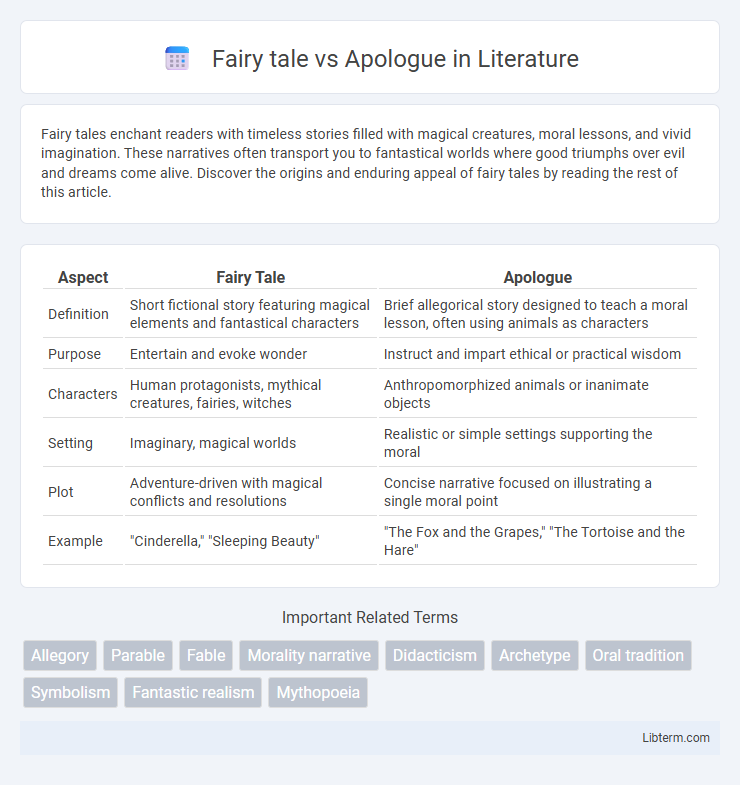Fairy tales enchant readers with timeless stories filled with magical creatures, moral lessons, and vivid imagination. These narratives often transport you to fantastical worlds where good triumphs over evil and dreams come alive. Discover the origins and enduring appeal of fairy tales by reading the rest of this article.
Table of Comparison
| Aspect | Fairy Tale | Apologue |
|---|---|---|
| Definition | Short fictional story featuring magical elements and fantastical characters | Brief allegorical story designed to teach a moral lesson, often using animals as characters |
| Purpose | Entertain and evoke wonder | Instruct and impart ethical or practical wisdom |
| Characters | Human protagonists, mythical creatures, fairies, witches | Anthropomorphized animals or inanimate objects |
| Setting | Imaginary, magical worlds | Realistic or simple settings supporting the moral |
| Plot | Adventure-driven with magical conflicts and resolutions | Concise narrative focused on illustrating a single moral point |
| Example | "Cinderella," "Sleeping Beauty" | "The Fox and the Grapes," "The Tortoise and the Hare" |
Introduction to Fairy Tales and Apologues
Fairy tales are traditional narratives featuring magical elements, fantastical creatures, and moral lessons often designed to entertain and instruct children. Apologues are brief, allegorical stories explicitly crafted to impart ethical or practical lessons, typically employing animals or inanimate objects as characters to symbolize human traits. Both genres serve educational purposes, but fairy tales emphasize imaginative storytelling, whereas apologues focus on direct moral instruction.
Defining Fairy Tales: Key Characteristics
Fairy tales are traditional short stories featuring magical beings, enchanted settings, and fantastical events designed to convey moral lessons or cultural values. They often include archetypal characters such as fairies, witches, and heroes undergoing transformative quests, highlighting universal themes of good versus evil. Unlike apologues, which primarily use animals as allegorical figures to teach a direct moral, fairy tales emphasize wonder and imagination through complex narrative structures and symbolic motifs.
What is an Apologue? Essential Features
An apologue is a brief allegorical narrative designed to convey a moral lesson, often featuring animals or inanimate objects as characters symbolizing human traits. Essential features include its didactic purpose, use of personification to embody abstract qualities, and a clear ethical message embedded within a simple, engaging storyline. Unlike fairy tales, apologues prioritize instruction over fantasy, emphasizing practical wisdom through metaphorical representation.
Historical Origins of Fairy Tales
Fairy tales originated from ancient oral traditions, evolving through centuries in diverse cultures as allegorical stories to convey moral lessons and cultural values. Early fairy tales were often rooted in folklore and mythology, blending magical elements with real-world settings to educate and entertain audiences. These narratives gave rise to apologues by refining moral instruction into concise fables featuring anthropomorphic characters, distinguishing the two genres in their historical development.
The Evolution and Purpose of Apologues
Apologues have evolved from simple moral stories into complex narratives designed to teach ethical lessons through animal characters and allegory, distinguishing themselves from fairy tales which primarily entertain with magical elements and fantastical settings. Rooted in ancient oral traditions and fables of Aesop, apologues serve the explicit purpose of imparting practical wisdom and societal values, often addressing human behavior and ethics directly. Their evolution reflects a shift toward using concise, symbolic storytelling to influence moral conduct and social norms across cultures.
Storytelling Techniques: Fairy Tales vs Apologues
Fairy tales rely on vivid imagery, magical elements, and archetypal characters to engage the imagination and convey cultural morals, often through episodic storytelling and symbolic settings. Apologues use concise, straightforward narratives with animal characters or personifications to deliver clear moral lessons, emphasizing direct cause-and-effect relationships in the plot. The storytelling in fairy tales typically explores universal themes through fantastical scenarios, while apologues prioritize clarity and rhetorical impact to teach practical wisdom.
Moral Lessons: Explicit vs Implicit Approaches
Fairy tales often present moral lessons through explicit narratives featuring clear distinctions between good and evil, making the intended values easily understandable for children. In contrast, apologues employ implicit moral teachings by using animals or inanimate objects as characters, requiring readers to interpret the underlying messages through metaphor and allegory. Both genres aim to impart ethical guidance, but fairy tales prioritize straightforward storytelling, while apologues rely on subtle, thought-provoking symbolism.
Key Differences in Structure and Form
Fairy tales typically feature magical elements, fantastical creatures, and a clear narrative arc with a beginning, middle, and end, aimed at entertaining and teaching moral lessons through imaginative storytelling. Apologues are concise, allegorical stories designed explicitly to impart a practical or ethical lesson, often using animals or inanimate objects as symbolic characters. Structurally, fairytales are longer and more elaborate, while apologues are brief, focused narratives emphasizing clear moral conclusions.
Prominent Examples of Fairy Tales and Apologues
Prominent examples of fairy tales include "Cinderella," "Snow White," and "Sleeping Beauty," which feature magical elements, fantastical worlds, and moral lessons conveyed through narrative enchantment. In contrast, notable apologues such as Aesop's "The Tortoise and the Hare" and La Fontaine's fables employ allegorical storytelling with anthropomorphic characters to explicitly illustrate ethical principles and practical wisdom. Both genres use storytelling to impart values, but fairy tales emphasize wonder and transformation, while apologues prioritize didactic clarity and succinct moral messaging.
Relevance and Influence in Modern Literature
Fairy tales, with their roots in folklore and myth, heavily influence modern literature by providing archetypal characters and moral lessons that resonate with contemporary readers. Apologues, often employing direct allegory and moral didacticism, shape narrative structures and ethical themes in modern literary works. The enduring relevance of both forms lies in their ability to reflect societal values and human psychology, reinforcing their significance in shaping literary traditions.
Fairy tale Infographic

 libterm.com
libterm.com